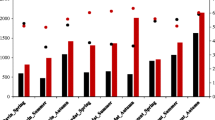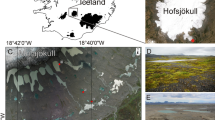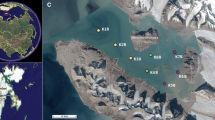Abstract
The sediment microbiota of the Mediterranean deep-sea anoxic hypersaline basins (DHABs) are understudied relative to communities in the brines and halocline waters. In this study, the active fraction of the prokaryotic community in the halocline sediments of L’ Atalante, Urania, and Discovery DHABs was investigated based on extracted total RNA and 454 pyrosequencing of the 16S rRNA gene. Bacterial and archaeal communities were different in the sediments underlying the halocline waters of the three habitats, reflecting the unique chemical settings of each basin. The relative abundance of unique operational taxonomic units (OTUs) was also different between deep-sea control sediments and sediments underlying DHAB haloclines, suggesting adaptation to the steep DHAB chemical gradients. Only a few OTUs were affiliated to known bacterial halophilic and/or anaerobic groups. Many OTUs, including some of the dominant ones, were related to aerobic taxa. Archaea were detected only in few halocline samples, with lower OTU richness relative to Bacteria, and were dominated by taxa associated with methane cycling. This study suggests that, while metabolically active prokaryotic communities appear to be present in sediments underlying the three DHABs investigated, their diversity and activity are likely to be more reduced in sediments underlying the brines.




Similar content being viewed by others
References
Akoumianaki I, Nomaki H, Pachiadaki M, Kormas KA, Kitazato H, Tokuyama H (2012) Low bacterial diversity and high labile organic matter concentrations in the sediments of the Medee deep-sea hypersaline anoxic basin. Microb Environ 27:504–508
Alcaide M, Stogios PJ, Lafraya Á, Tchigvintsev A, Flick R, Bargiela R, Chernikova TN, Reva ON, Hai T, Leggewie CC, Katzke N, La Cono V, Matesanz R, Jebbar M, Jaeger KE, Yakimov MM, Yakunin AF, Golyshin PN, Golyshina OV, Savchenko A, Ferrer M, Consortium M (2015) Pressure adaptation is linked to thermal adaptation in salt-saturated marine habitats. Environ Microbiol 17:332–345
Alexander E, Stock A, Breiner H-W, Behnke A, Bunge J, Yakimov MM, Stoeck T (2009) Microbial eukaryotes in the hypersaline anoxic L’Atalante deep-sea basin. Environ Microbiol 11:360–381
Baross JA, Hanus FJ, Morita RY (1975) Survival of human enteric and other sewage microorganisms under simulated deep sea conditions. J Appl Microbiol 30:309–318
Bernhard JM, Kormas KA, Pachiadaki MG, Rocke E, Beaudoin DJ, Morrison C, Visscher PT, Cobban A, Starczak VR, Edgcomb VP (2014) Benthic protists and fungi of Mediterranean deep hypsersaline anoxic basin redoxcline sediments. Front Microbiol 5:605
Blazewicz SJ, Barnard RL, Daly RA, Firestone MK (2013) Evaluating rRNA as an indicator of microbial activity in environmental communities: limitations and uses. ISME J 7:2061–2068
Borin S, Brusetti L, Mapelli F, D’Auria G, Brusa T, Marzorati M, Rizzi A, Yakimov M, Marty D, De Lange GJ, Van der Wielen P, Bolhuis H, McGenity TJ, Polymenakou PN, Malinverno E, Giuliano L, Corselli C, Daffonchio D (2009) Sulfur cycling and methanogenesis primarily drive microbial colonization of the highly sulfidic Urania deep hypersaline basin. Proc Natl Acad Sci 106:9151–9156
Camerlenghi A (1990) Anoxic basins of the eastern Mediterranean: geological framework. Mar Chem 31:1–19
Campbell B, Yu L, Straza T, Kirchman D (2009) Temporal changes in bacterial rRNA and rRNA genes in Delaware (USA) coastal waters. Aquat Microb Ecol 57:123–135
Chubukov V, Gerosa L, Kochanowski K, Sauer U (2014) Coordination of microbial metabolism. Nat Rev Microbiol 12:327–340
Cita MB (2006) Exhumation of Messinian evaporites in the deep-sea and creation of deep anoxic brine filled collapsed basins. Sedim Geol 188–189:357–378
Corinaldesi C, Tangherlini M, Luna GM, Dell’Anno A (2014) Extracellular DNA can preserve the genetic signatures of present and past viral infection events in deep hypersaline anoxic basins. Proc Royal Soc B Biol Sci 281:20133299
Daffonchio D, Borin S, Brusa T, Brusetti L, van der Wielen PWJJ, Bolhuis H, Yakimov MM, D’Auria G, Giuliano L, Marty D, Tamburini C, McGenity TJ, Hallsworth JE, Sass AM, Timmis KN, Tselepides A, de Lange GJ, Hübner A, Thomson J, Varnavas SP, Gasparoni F, Gerber HW, Malinverno E, Corselli C (2006) Stratified prokaryote network in the oxic-anoxic transition of a deep-sea halocline. Nature 440:203–207
Danovaro R, Dell’Anno A, Pusceddu A, Gambi C, Heiner I, Mobjerg Kristensen R (2010) The first metazoa living in permanently anoxic conditions. BMC Biol 8:30
de la Haba RR, Sánchez-Porro C, Marquez MC, Ventosa A (2011) Taxonomy of halophiles. In: Horikoshi K (ed) Extremophiles handbook. Springer, Tokyo, pp 255–308
Dell’Anno A, Bompadre S, Danovaro R (2002) Quantification, base composition, and fate of extracellular DNA in marine sediments. Limnol Oceanogr 47:899–905
Dorador C, Meneses D, Urtuvia V, Demergasso C, Vila I, Witzel K-P, Imhoff JF (2009) Diversity of Bacteroidetes in high-altitude saline evaporitic basins in northern Chile. J Geophys Res Biogeosci 114:G00D05
Dowd S, Callaway T, Wolcott R, Sun Y, McKeehan T, Hagevoort R, Edrington TS (2008) Evaluation of the bacterial diversity in the feces of cattle using 16S rDNA bacterial tag-encoded FLX amplicon pyrosequencing (bTEFAP). BMC Microbiol 8:125
Edgcomb V, Orsi W, Leslin C, Epstein SS, Bunge J, Jeon S, Yakimov MM, Behnke A, Stoeck T (2009) Protistan community patterns within the brine and halocline of deep hypersaline anoxic basins in the eastern Mediterranean Sea. Extremophiles 13:151–167
Edgcomb VP, Orsi W, Breiner H-W, Stock A, Filker S, Yakimov MM, Stoeck T (2011) Novel kinetoplastids associated with hypersaline anoxic lakes in the Eastern Mediterranean deep-sea. Deep-Sea Res I 58:1040–1048
Eloe EA, Shulse CN, Fadrosh DW, Williamson SJ, Allen EE, Bartlett DH (2011) Compositional differences in particle-associated and free-living microbial assemblages from an extreme deep-ocean environment. Environ Microbiol Rep 3:449–458
Ferrer M, Werner J, Chernikova TN, Bargiela R, Fernández L, La Cono V, Waldmann J, Teeling H, Golyshina OV, Glöckner FO, Yakimov MM, Golyshin PN, The MSC (2012) Unveiling microbial life in the new deep-sea hypersaline Lake Thetis. Part II: a metagenomic study. Environ Microbiol 14:268–281
Huertas IE, Ríos AF, García-Lafuente J, Navarro G, Makaoui A, Sánchez-Román A, Rodriguez-Galvez S, Orbi A, Ruíz J, Pérez FF (2012) Atlantic forcing of the Mediterranean oligotrophy. Global Biogeochem Cycles 26:GB2022
Ives AR, Carpenter SR (2007) Stability and diversity of ecosystems. Science 317:58–62
Jones SE, Lennon JT (2010) Dormancy contributes to the maintenance of microbial diversity. Proc Natl Acad Sci 107:5881–5886
Kamke J, Taylor MW, Schmitt S (2010) Activity profiles for marine sponge-associated bacteria obtained by 16S rRNA vs 16S rRNA gene comparisons. ISME J 4:498–508
Kang SH, Evans P, Morrison M, McSweeney C (2013) Identification of metabolically active proteobacterial and archaeal communities in the rumen by DNA- and RNA-derived 16S rRNA gene. J Appl Microbiol 115:644–653
Kerhervé P, Heussner S, Charrière B, Stavrakakis S, Ferrand J-L, Monaco A, Delsaut N (1999) Biogeochemistry and dynamics of settling particle fluxes at the Antikythira Strait (Eastern Mediterranean). Progr Oceanogr 44:651–675
Klindworth A, Pruesse E, Schweer T, Jr Peplies, Quast C, Horn M, Glöckner FO (2012) Evaluation of general 16S ribosomal RNA gene PCR primers for classical and next-generation sequencing-based diversity studies. Nucleic Acids Res 41:e1
Konopka A (2009) What is microbial community ecology? ISME J 3:1223–1230
Krumbein WE, Gorbushina AA, Holtkamp-Tacken E (2004) Hypersaline microbial systems of sabkhas: examples of life’s survival in “extreme” conditions. Astrobiology 4:450–459
Kunin V, Engelbrektson A, Ochman H, Hugenholtz P (2010) Wrinkles in the rare biosphere: pyrosequencing errors can lead to artificial inflation of diversity estimates. Environ Microbiol 12:118–123
La Cono V, Smedile F, Bortoluzzi G, Arcadi E, Maimone G, Messina E, Borghini M, Oliveri E, Mazzola S, L’Haridon S, Toffin L, Genovese L, Ferrer M, Giuliano L, Golyshin PN, Yakimov MM (2011) Unveiling microbial life in new deep-sea hypersaline Lake Thetis. Part I: prokaryotes and environmental settings. Environ Microbiol 13:2250–2268
Lauro FM, Bertoloni G, Obraztsova A, Kato C, Tebo BM, Bartlett DH (2004) Pressure effects on Clostridium strains isolated from a cold deep-sea environment. Extremophiles 8:169–173
Lloyd KG, Lapham L, Teske A (2006) An anaerobic methane-oxidizing community of ANME-1b archaea in hypersaline gulf of Mexico sediments. Appl Environ Microbiol 72:7218–7230
Lomas MW, Moran SB (2011) Evidence for aggregation and export of cyanobacteria and nano-eukaryotes from the Sargasso Sea euphotic zone. Biogeosciences 8:203–216
Loreau M (2010) Linking biodiversity and ecosystems: towards a unifying ecological theory. Philos Trans Royal Soc B Biol Sci 365:49–60
Loreau M, Naeem S, Inchausti P, Bengtsson J, Grime JP, Hector A, Hooper DU, Huston MA, Raffaelli D, Schmid B, Tilman D, Wardle DA (2001) Biodiversity and ecosystem functioning: current knowledge and future challenges. Science 294:804–808
Magurran AE, McGill BJ (eds) (2011) Biological diversity. Frontiers in measurement and assessment. Oxford University Press, Oxford
Maignien L, Parkes RJ, Cragg B, Niemann H, Knittel K, Coulon S, Akhmetzhanov A, Boon N (2013) Anaerobic oxidation of methane in hypersaline cold seep sediments. FEMS Microbiol Ecol 83:214–231
Morgan-Smith D, Garrison CE, Bochdansky AB (2013) Mortality and survival of cultured surface-ocean flagellates under simulated deep-sea conditions. J Exp Mar Biol Ecol 445:13–20
Morris RM, Rappé MS, Urbach E, Connon SA, Giovannoni SJ (2004) Prevalence of the Chloroflexi-related SAR202 bacterioplankton cluster throughout the mesopelagic zone and deep ocean. Appl Environ Microbiol 70:2836–2842
Nedashkovskaya OI, Kim SB, Han SK, Lysenko AM, Rohde M, Rhee M-S, Frolova GM, Falsen E, Mikhailov VV, Bae KS (2004) Maribacter gen. nov., a new member of the family Flavobacteriaceae, isolated from marine habitats, containing the species Maribacter sedimenticola sp. nov., Maribacter aquivivus sp. nov., Maribacter orientalis sp. nov. and Maribacter ulvicola sp. nov. Int J Syst Evolut Microbiol 54:1017–1023
Nedashkovskaya OI, Kim SB, Zhukova NV, Kwak J, Mikhailov VV, Bae KS (2006) Mesonia mobilis sp. nov., isolated from seawater, and emended description of the genus Mesonia. Int J Syst Evolut Microbiol 56:2433–2436
Orchard VA, Cook FJ (1983) Relationship between soil respiration and soil moisture. Soil Biol Biochem 15:447–453
Pachiadaki MG, Yakimov MM, LaCono V, Leadbetter E, Edgcomb V (2014) Unveiling microbial activities along the halocline of Thetis, a deep-sea hypersaline anoxic basin. ISME J 8:2478–2489
Park T-G, Bolch CJS, Hallegraeff GM (2007) Morphological and molecular genetic characterization of Cryptoperidiniopsis brodyi (Dinophyceae) from Australia-wide isolates. Harmful Algae 6:718–733
Picard A, Daniel I (2014) Pressure as an environmental parameter for microbial life: a review. Biophys Chem 183:30–41
Pruesse E, Quast C, Knittel K, Fuchs B, Ludwig W, Peplies J, Glöckner F (2007) SILVA: a comprehensive online resource for quality checked and aligned ribosomal RNA sequence data compatible with ARB. Nucleic Acids Res 35:7188–7196
Quince C, Lanzen A, Curtis TP, Davenport RJ, Hall N, Head IM, Read LF, Sloan WT (2009) Accurate determination of microbial diversity from 454 pyrosequencing data. Nat Meth 6:639–641
Sass AM, Sass H, Coolen MJL, Cypionka H, Jr Overmann (2001) Microbial communities in the chemocline of a hypersaline deep-sea basin (Urania Basin, Mediterranean Sea). Appl Environ Microbiol 67:5392–5402
Sass AM, McKew BA, Sass H, Fichtel J, Timmis KN, McGenity TJ (2008) Diversity of Bacillus-like organisms isolated from deep-sea hypersaline anoxic sediments. Saline Syst 4:8
Schattenhofer M, Fuchs BM, Amann R, Zubkov MV, Tarran GA, Pernthaler J (2009) Latitudinal distribution of prokaryotic picoplankton populations in the Atlantic Ocean. Environ Microbiol 11:2078–2093
Schloss PD, Westcott SL, Ryabin T, Hall JR, Hartmann M, Hollister EB, Lesniewski RA, Oakley BB, Parks DH, Robinson CJ, Sahl JW, Stres B, Thallinger GG, Van Horn DJ, Weber CF (2009) Introducing mothur: open-source, platform-independent, community-supported software for describing and comparing microbial communities. Appl Environ Microbiol 75:7537–7541
Sekbach J (ed) (2006) Life as we know it. Springer, Dordrecht
Smeti E, Kormas KA, Spatharis S (2013) A non-phylogenetic alpha diversity approach on prokaryotic community structure in aquatic systems. Ecol Indic 29:361–366
Sorokin DY (1995) Sulfitobacter pontiacus gen. nov., sp. nov.—a new herotrophic bacterium from the Black Sea, specialized on sulfite oxidation. Microbiology 64:295–305
Stackebrandt E, Goebel BM (1994) Taxonomic note: a place for DNA: DNA reassociation and 16S rRNA sequence analysis in the present species definition in bacteria. Int J Syst Bacteriol 44:846–849
Stevens H, Ulloa O (2008) Bacterial diversity in the oxygen minimum zone of the eastern tropical South Pacific. Environ Microbiol 10:1244–1259
Stoeck T, Filker S, Edgcomb V, Orsi W, Yakimov MM, Pachiadaki M, Breiner HW, LaCono V, Stock A (2014) Living at the limits: evidence for microbial eukaryotes thriving under pressure in deep anoxic, hypersaline habitats. Adv Ecol 2014:9
Takai K, Horikoshi K (2000) Rapid detection and quantification of members of the archaeal community by quantitative PCR using fluorogenic probes. Appl Environ Microbiol 66:5066–5072
van der Wielen PWJJ, Bolhuis H, Borin S, Daffonchio D, Corselli C, Giuliano L, D’Auria G, de Lange GJ, Huebner A, Varnavas SP, Thomson J, Tamburini C, Marty D, McGenity TJ, Timmis KN, Party BS (2005) The enigma of prokaryotic life in deep hypersaline anoxic basins. Science 307:121–123
Ward BB, O’Mullan GD (2002) Worldwide distribution of Nitrosococcus oceani, a marine ammonia-oxidizing γ-Proteobacterium, detected by PCR and sequencing of 16S rRNA and amoA genes. Appl Environ Microbiol 68:4153–4157
Whitman WB, Coleman DC, Wiebe WJ (1998) Prokaryotes: the unseen majority. Proc Natl Acad Sci USA 95:6578–6583
Yakimov M, Giuliano L, Cappello S, Denaro R, Golyshin P (2007a) Microbial community of a hydrothermal mud vent underneath the deep-sea anoxic brine lake Urania (Eastern Mediterranean). Orig Life Evolut Biosph 37:177–188
Yakimov MM, La Cono V, Denaro R, D’Auria G, Decembrini F, Timmis KN, Golyshin PN, Giuliano L (2007b) Primary producing prokaryotic communities of brine, interface and seawater above the halocline of deep anoxic lake L’Atalante, Eastern Mediterranean Sea. ISME J 1:743–755
Yakimov MM, La Cono V, Slepak VZ, La Spada G, Arcadi E, Messina E, Borghini M, Monticelli LS, Rojo D, Barbas C, Golyshina OV, Ferrer M, Golyshin PN, Giuliano L (2013) Microbial life in the Lake Medee, the largest deep-sea salt-saturated formation. Sci Rep 3:3554
Acknowledgments
We would like to thank the crew of the R/V Atlantis and the ROV Jason team for making possible the investigations of cruise AT18-14. This work was supported by NSF OCE-0849578 to VE and JB and OCE-1061391 to JB and VE. MP was supported by the WHOI postdoctoral scholarship program. KAK was partially supported by the University of Thessaly through a sabbatical in 2013. This paper is dedicated to the memory of Edward R. Leadbetter.
Author information
Authors and Affiliations
Corresponding author
Additional information
Communicated by A. Oren.
E. R. Leadbetter: deceased.
Electronic supplementary material
Below is the link to the electronic supplementary material.
Rights and permissions
About this article
Cite this article
Kormas, K.A., Pachiadaki, M.G., Karayanni, H. et al. Inter-comparison of the potentially active prokaryotic communities in the halocline sediments of Mediterranean deep-sea hypersaline basins. Extremophiles 19, 949–960 (2015). https://doi.org/10.1007/s00792-015-0770-1
Received:
Accepted:
Published:
Issue Date:
DOI: https://doi.org/10.1007/s00792-015-0770-1




